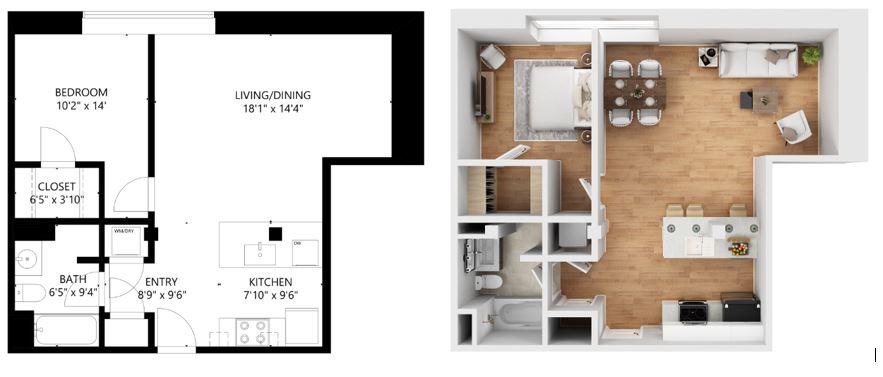These plans are made to expand with the goal that the rational elements of the rooms are used effectively. This is to assist in limiting development errors while realizing the project structure.
1. TYPES OF FLOOR PLANS
There are mainly two types of floor plans, which are furnished and unfurnished floor plans.
Unfurnished Floor Plan
The unfurnished floor plans include:
- 2D Classic Floor Plan: A classic 2D floor plan is a sketch showing the design of an asset or space from above in black and white. Typically, these types of floor plans show that it is a “level” drawing, without a point of view or profundity.
- 2D Colored Floor Plan: A 2D color floor plan is a sketch showing the design of an asset or space from a bird’s eye perspective in color. It will often show partitions and room designs, in addition to fixed facilities such as windows and entrances.
Furnished Floor Plan
The furnished floor plan includes:
- 2D Textured Floor Plan: If you want to use the floor plan to exhibit the home’s structure just as the components, for instance, flooring and outside space? A 2D textured floor plan will feature components like furniture, ensuites, tiles,… and gives significantly more detail to potential buyers.
- 3D Floor Plan: A 3D floor plan, or 3D floor arrangement, is a virtual model of a structure floor plan, delineated from a superior view, used inside the real estate business to all the more likely pass on building plans.
2. WHY YOU MUST DEVELOP A FLOOR PLAN DESIGN?
The floor plan is genuinely a new inclusion to property subtleties. There are three components to a plan that make it significant.
- Floor plans help buyers to be aware of how a home operates and whether they may want to see it. Room flow, format, and size are completely factors that buyers need to ponder, especially if they are looking for a family home. Buyers aren’t going to burn through their time participating in the properties won their needs.
- In addition, floor plans help buyers visualize the home after they see it. This is essential when considering design changes such as evacuating walls or introducing an additional restroom.
- Finally, floor plans can make an asset seem larger. It’s extremely simple to skip rooms you’ve seen when reviewing homes or skipping a whole bit of house. This is especially valid for attics, basements and different usable areas without limitation. By proving the house is complete on the floor plans, buyers have seen the value included.
3. BENEFITS OF FLOOR PLANS
As we all know, floor plans give you a bird’s-eye view of a structure. It arranges a scale chart of a room, house or works as drawn by a house creator or sketch artist. Typically, it introduces the connection between rooms, furniture, space and shows estimates (called lines) to what extent, in fact.
Similarly, it fills in as an important link mechanism between designers, builders, and clients. It allows specialized testing of structures and carefully calculated estimates required nearby like data related to area details for the last client.
- The floor plans convert your thoughts into images with goals that you will be sure of what should be done. It shows that the final product will be similar to the target that you can evaluate early and update if necessary.
The blueprint is your level of work and guidance. It makes it all simple to make changes before tracking the structure. - By having an accurate floor plan with estimates, you can choose the materials or furniture you need to use and how they will fit into the location. Hence, they give you an opportunity to design your home better.
- Floor plans are important for real estate organizations to communicate room progress to potential buyers or tenants.
- A floor plan also encourages you to discuss your thoughts with the advanced staff.
- A floor plan encourages you to discuss your thoughts with the enhancement workers.
In conclusion, make sure you have a story plan when promoting your property. Add it to your booklet and try to make it accessible independently as download using online property portals. Ensuring the arrangement is clear and incorporates the entire floor territory. It may simply be the component that brings the deal close.

